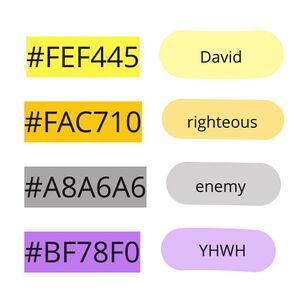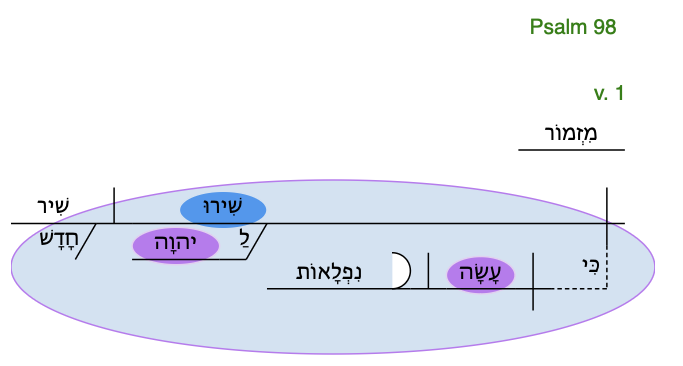Participant Analysis
- Grammar
- Semantics
- Exegetical Issues
- Discourse
- Poetics
- Synthesis
- Close-but-Clear
- Videos
- Post to wiki
Introduction
The participant analysis (or co-reference) visualisation is an overlay based on the grammatical diagram. It asks, What “story” do the characters of this psalm tell? The answer to this question begins by identifying the main participants in the psalm, along with their grammatical function (Part I). The following steps trace the relationships between participants (Part II), and the final steps summarise the “story” that the participants of the psalm tell (Part III).
Required Materials and Tools
- Open-source Hebrew text: OSHB Read, also available on the Psalms: Layer by Layer forum.
- Polished grammatical diagram (Creator Guidelines)
- Note: These instructions are based on the Grammar 300.1 video, but have been developed further since the video was made.
Steps
1. Track participants.
A. Diagram the text.
If there’s already a diagram, review it, and revise if necessary, before uploading to Miro.
B. Highlight all participants.
A participant is an “agent, individual or corporate, who plays a unique relational role in the story of the psalm” (working definition). Relationships between participants distinguish them from each other, so those with the same role (e.g. mother and father) may be grouped into one participant. Participants are nearly always volitional, but not always in a traditional sense (e.g. the earth may enter into relationship with God and thereby become a participant).
If using Miro, by using the highlighter feature, mark each participant on the diagram. If there are non-personal subjects with a character-like role in the psalm (e.g. the “tree” and “chaff” from Psalm 1), highlight those too.
If using the online diagrammer, add <highlight="participantgroups"> after the first line, so your line may look like:
DiscourseUnit [Psalm 98] <highlight="participantgroups">
Then, on the same line as a participant, add <participant="NAME">, such as
noun: יהוָה <participant="YHWH"> verb: שִׁירוּ <participant="Israel">
The known participants for the online diagrammer are: David, King, People, Israel, YHWH, Enemies, Nations, Earth.
This analysis differentiates between two types of participants: subject and predicative. Subject participants include both the grammatical subject and the accompanying verb(s) (including those with implied subjects). Hebrew is a “pro-drop” language, so its verbs do not require an explicit subject; subject participants often occur merely through verbal morphology.
Predicative participants include all other (non-subject) grammatical functions like direct objects, nouns in prepositional or construct phrases, and pronouns.
Use this colour scheme for frequently-recurring participants:
- Protagonist (e.g., David, Asaph, often the “I” of the psalm): yellow (#FEF445)
- The righteous person(s): orange (#FAC710)
- Antagonist (e.g., wicked, enemies, nations, etc.): grey (#A8A6A6)
- YHWH: purple (#BF78F0)
Assign colours to any new participants. As a general rule, use similar colours to reflect relational proximity. For example, if there are multiple closely-related antagonists, these may be identified with shades of the same colour (e.g., nations and earthly kings in Ps. 2).
Provide a key to indicate participants and their colours (see example below).
Do not highlight elided participants.
C. Indicate all grammatical possibilities.
Where the participant reference is ambiguous, mark your preferred reading normally but include the alternative possibility as dots above the word in question.
For example, in Ps 1:3, the verb יצליח has three possible subjects. Each possibility is represented on the diagram as a colour (the man [yellow], the tree [orange], and YHWH [purple]), though "the man" is the preferred reading.
2. Identify combinations and patterns.
A. Make note of participant sets.
Participant sets are simply closely-related participants that act like a single participant by virtue of their literary function. For instance, the “man” and the “tree” in Psalm 1 are a participant set: they are closely related in the psalm, and therefore can be considered a single participant for the sake of analysis. Similarly, the “nations” and “kings of the nations” in Ps 2:1–2 are closely related and function as a single participant in Psalm 2.
Note on a special case: when two contrasting participants (e.g. “vile person” and “YHWH-fearers”) occur as examples of a larger category that also appears in the text (e.g. "neighbour"), highlight each as discrete participant but consider them part of the same participant set (in this case, "neighbour"). In addition, on the grammatical diagram and PA table, the contrasting participants should appear in their discrete colour but be boxed in the colour of the category to which they belong. See the PA diagram for Psalm 15 for an example.
B. Circle grammatical combinations.
A grammatical combination obtains where multiple participants (or participant sets) occur together in the same clause or series of clauses (e.g. when participants are consistent subject-predicative participant pairs). The size of each circle may vary from a single clause to a string of several clauses, depending on the span of text with a consistent participant combination.
Use the subject’s colour as the circle fill colour and the predicative participant as the circle outline colour. If there are multiple predicate participants, you may need multiple borders (in Miro, multiple nested circles). As with the participants, add a key which lists combinations.
The online diagrammer can currently only indicate one predicative participant. Indicate subject and predicative participants like this:
Fragment <subjectParticipant="Israel" predicativeParticipant="YHWH">
C. Indicate the speaker(s) and addressee(s) of the psalm.
Draw two vertical bars on the right side of the diagram, and label. Vocative words should be placed in a coloured box connected to the addressee column.
For quoted speech, place a box within the column.
Note: The identity of the addressee is not always immediately clear, especially when a person shift occurs when addressing YHWH. As a general principle, unless there is good reason to posit a third party (i.e., a new addressee), then YHWH is still the addressee, even when spoken of in third person.
D. Chart participant activity.
Create a table with one row for each clause.
Make columns for the following:
- verse + line number
- speaker
- addressee
- subject + (grammatical) person + (grammatical) number
- predicative participant + (grammatical) person + (grammatical) number
Indent to indicate grammatical subordination. Note: to indent, select the text and use the Miro indent function (see image below).

If there is a non-participant subject, include this in the chart, but do not highlight it. If the participant appears as a pronominal suffix attached to a noun (in either subject or predicate), include both the participant and the noun; highlight only the participant. If the sentence is intransitive (i.e. having no predicative participant), then just leave the table cell blank.
Examining the data in the table, note shifts in speaker, addressee, subject, and/or predicative participant. Draw lines across the table based on these shifts, and provide a brief label describing the reason for the line (see template for examples). Adjust the thickness of each line based on your estimation of the relevance of the division. Do your best to determine divisions based only on the participant activity chart, not on other structural features. Other structural features will be considered in other layers.
(Note that including grammatical number is a recent addition, so the examples don't yet represent that.)
3. Summarise.
A. Create a visual summary of participant relations.
This visual summary represents one way to visualise how the participants relate to each other. Distill each relationship to just a few words, and display this in a graphic like this example from Psalm 6.
Note: Irrealis actions (e.g. imperatives) should be included in parentheses.
Note: If there is no participant relationship in the psalm, omit the connecting arrow altogether.
B. Write a participant “mini-story.”
Write a summary of these participant relationships in just one or two sentences. Focus on the key relationships between participants and events affecting those relationships. The mini-story need not follow the psalm’s order of presentation. Use plain English (avoid figurative language that is not itself found in the psalm) and highlight the participants with the appropriate colours.
Appendix: Examples
DiscourseUnit [Psalm 98] <highlight="participantgroups">
Fragment [v. 1]
noun: מִזְמוֹר
Fragment <subjectParticipant="Israel" predicativeParticipant="YHWH">
Clause
Predicate
verb: שִׁירוּ <participant="Israel">
Adverbial
PrepositionalPhrase
Preposition
preposition: לַ
Object
noun: יהוָה <participant="YHWH">
Object
noun: שִׁיר
adjective: חָדָשׁ
SubordinateClause
Conjunction
conjunction: כִּי
Clause
Predicate
verb: עָשָׂה <participant="YHWH">
Object
verb-participle: נִפְלָאוֹת
N.B. The white semicircle inside the curved line for the participle is a bug. It will be fixed.
Additional Resources
Participant Reference
Analyzing Discourse: A Manual of Basic Concepts. Open access book by Robert Dooley and Stephen Levinsohn (SIL: 2000). Especially Chapter 17: "Strategies of Reference."
De Regt, Lénart J., “Participant Reference in Discourse: Biblical Hebrew.” In Encyclopedia of Hebrew Language and Linguistics. Edited by Geoffrey Khan.
Jacobson, Rolf A. Many Are Saying: The Function of Direct Discourse in the Hebrew Psalter. Library of Hebrew Bible/Old Testament Studies 397. New York: T&T Clark, 2004.












